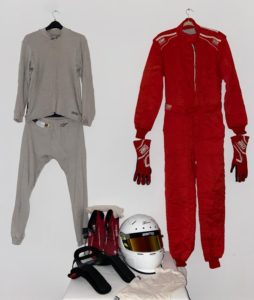License and Personal Protective Equipment
Starter Pack. A Motorsport UK Starter Pack are the gateway to your first Motorsport UK Race Competition Licence. The minimum license for circuit racing is a ‘Race Club’. You can purchase your starter pack from getstarted.motorsportuk.org or call them on 01753 765000.
Medical. If you are a first-time applicant and depending on your age, you might need a medical before applying for your race license. These can be done by your GP and are similar in style to medicals done for life insurance purposes.
ARDS Test Once you have purchased a pack you will need to book and pass a course (ARDS Test) with an accredited school: Look for one of the many available ARDS courses via www.ards.co.uk
Memberships. You will need to become a ‘Racing’ member of the 2CV racing Club. Membership will provide you with your racing number, important race information, ‘Snails Pace’ club magazine, invites to social events, club discount schemes and will allow you to score points in our championship rounds. www.2cvracing.org.uk
Its also necessary to become a member of The British Automobile Racing Club (BARC) who will provide you with your race entries and information, club discount scheme, club magazine and race dates throughout the year. Look at the BARC website here:- http://www.barc.net
 Personal Protective equipment. To step in to a race car you will need to have the following equipment (PPE), to the correct standards and in good condition. These standards are set out in the MSUK ‘Yearbook’ or rulebook, but the guide and picture below may help.
Personal Protective equipment. To step in to a race car you will need to have the following equipment (PPE), to the correct standards and in good condition. These standards are set out in the MSUK ‘Yearbook’ or rulebook, but the guide and picture below may help.
- Race Helmet– Every competitor will need a SNELL or FIA verified and approved helmet, which is always checked by a scrutineer at every race meeting you compete in. Any helmet bought from new can be used for 10 years from when they were first homologated.
- Race Suit– An FIA approved race suit is critical – all of them are made of fireproof materials, however each brand will develop theirs differently depending on size, design and comfort levels.
- Gloves– These come in a range of different brands, designs, colours and sizes depending on personal preference and comfort.
- Boots– Just like the gloves, race boots are key to ensure a comfortable driving experience while still providing appropriate levels of grip and feel on the pedals when accelerating and braking.
- HANS Device or Frontal Head Restraint– This is vital to ensure that in the event of an accident, your head and neck stay secure and safe to prevent any form of injury as much as possible. There are options of using either a full HANS device, an adjustable harness or a hybrid system developed by companies such as Simpson. Whichever you choose, safety in a race car shouldn’t be compromised, so we recommend using one of these devices whenever you’re out on track.
- Fireproof Underwear– This acts as a second layer of sorts and is worn underneath your race suit. While it isn’t mandatory to wear it, it is another element we strongly advise you purchase.
Approximate costs to get yourself ready to step in to a car can vary wildly depending on the equipment you buy. For example helmets can range from £200 to £1000’s. Expect to spend around £1500 to £2000 for a good quality set of PPE and to get your license. Then all you need is…….
A race car. Race cars can be built yourself, borrowed, bought and hired. There is nothing stopping you from getting on the track. Check out the recent ‘Autosport’ article on building a race 2CV
Vehicle Safety equipment. Cars need to comply with current MSUK safety requirements. You will need a roll cage, fire extinguisher, racing harness, seat, plus other less expensive safety items. The MSUK Yearbook will list all safety requirements that must be met for circuit racing. Fire extinguishers should have been recently checked or re-filled and harnesses should be ‘in-date’ as they have a lifespan, the expiry of which is marked on the belts near the buckle fastening.
Championship Regulations. Not only will your car need to comply with the MSUK minimum requirements, but you will also need to comply with the Current 2CV Racing Championship ‘Technical regulations’. These can be found at www.2cvracing.org.uk or www.barc.net
History
The whole concept of 2CV racing is that it’s an inexpensive, fun formula that allows you onto the motorsports ladder so that means that anybody can do it, novice or experienced. There is always help at hand either via our website, on race days or by phone. Team spirit and a family friendly atmosphere is what we try to provide at all events.
The rules have been written by the drivers for the drivers with cost and safety in mind. The cost of building a 2CV racing car can be as little as £1500-£2000, but this depends on how much work you do yourself and how competitive you want to be. Alternatively second hand race cars are generally available on our website, forum or Ebay.
Technical Information
Engines. Sensible engine tuning means engines can last a couple of seasons, including a 24-hour between rebuilds, and it only costs between £1000 and £2000 to build in the first place. They are a simple and interesting unit to work on and performance is better than most people think. With 40-50BHP and with the car weighing only 665Kg the cars can still do some surprising speeds.
Modifications. These are limited and include items such as higher (9.0:1) compression pistons, gas flowed cylinder heads, lightened flywheels, a mandatory control camshaft 2CV racing club approved Lumenition electronic ignition. Other modifications Include Weber Carburettor and modified exhaust systems.
The engine technical regulations, as with all the technical regulations apply to all championship races.
Chassis. In the current 2CV rules, you have the choice of several Chassis. There is not much difference between them in performance, the standard Citroen chassis is the lightest, whilst the SLC is slightly stiffer than the replacement chassis sold for road use. Also the Frome Chassis is allowed but tends to be only found on older cars nowadays.
Roll cages. Must be as per the MSUK Yearbook for saloon cars. The addition of a bar between each front and each rear foot of the cage is compulsory, please refer to the regulations for the details of this bar.
Wheels & tyres. Tyres must be 135 x 80 x 15 inch TOYO road tyres. A couple of sets can last more than a complete season – not including the 24-hour race when between 6 and 8 tyres may be needed to complete the distance. Tyres are available through club suppliers at a discount price. Standard Citroen 2cv original road wheels must be used & are available discounted to 2cv racers.
Suspension. The one area where racing 2CVs are noticeably different from road 2CVs, is that the race 2CVs suspension has been lowered and stiffened. This means there is none of that ‘scraping the door mirrors on the road’ when cornering like standard road 2CVs. Spring rates are generally increased anywhere from 200-500% over standard springs which coupled to light weight makes them very agile on the track, enough to surprise other race cars on a test day. Corner speed is the Holy Grail. Modifications required to achieve racing quality handling are very limited, modified front arms (camber and caster adjustments) can be supplied by a number of teams or simply modify them yourself to reduce the costs.
Shock absorbers. Can be replaced with alternatives and bump stops can be removed. Camber and caster angles are free on front and rear axles. It is also possible to fit an Ami 8 anti roll bar to the front suspension.
Steering. The steering rack must be standard, while track rod adjusters can be strengthened or replaced. Through the racing club it is possible to buy strengthened adjuster sets which is recommended. The steering column must have a universal joint added to the bottom end. This means you can lower the steering wheel position to suit your driving position. Standard wheel bearings and kingpins are still used; however the front suspension arms are usually modified to support the top of the kingpin. This is known as ‘The Belgian arm mod’ due to its origins in the European series.
Exhausts. Race systems must pass MSA noise levels. There are two main types of system used, a modified road system or a 2 into 1 system.
The basic rule of thumb is that the standard system gives better torque and is easy to fit onto existing mountings whilst the 2 into 1 gives better top end power.
Gearbox. A standard 2CV6 602cc gearbox is used (Dyane or 2CV4 gearboxes are not allowed), the only modifications permitted are that you can extend the gear stick and put a blanking pug in the speedo cable hole if no speedometer is fitted to the car. Gearboxes, even in race trim, seem to last for ever, and can be easily rebuilt.
Brakes. The standard 2CV braking system is used and is more than capable of lasting the 24-hour race even in road car condition. 2CVs from the mid ’70s onwards had discs on the front and drums on the rear. Most importantly the front brake calipers should be serviced (fit new seals and replace fluid. LHM fluid only). To help prevent overheating, heat sinks can be fitted to the callipers to help dissipate heat. Brake pads are free, and there are a number of different pads on the market. But in general the standard original Citroen front brake pad is just as good.
Exterior. It is mandatory to remove rear bumper and the front bumper, which is replaced with a front spoiler. The side and rear windows can be replaced with 4mm thick Perspex sheet. Glass reinforced bonnets, front & rear wings are allowed. The mandatory front spoiler is available to racing club members.
Technical regulations. The latest complete set of technical regulations are available through this link: Click here
